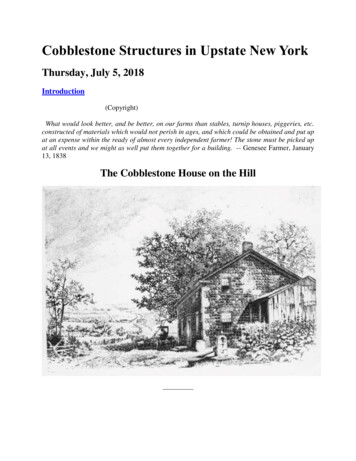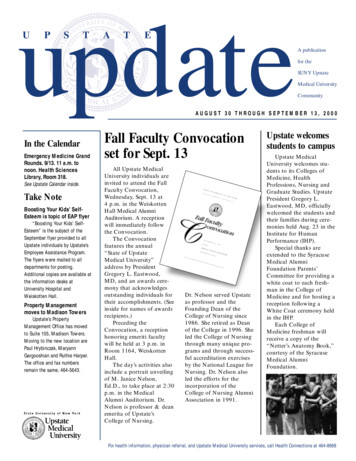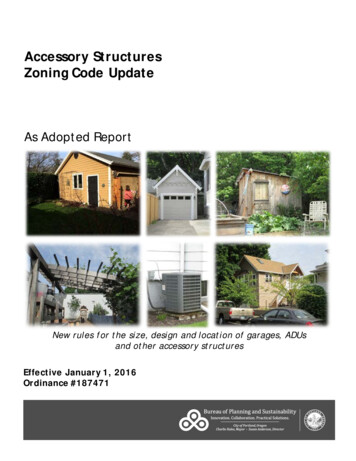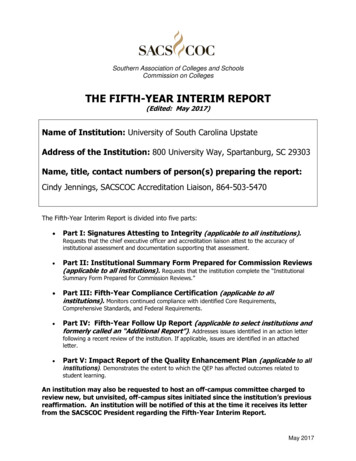
Transcription
Cobblestone Structures in Upstate New YorkThursday, July 5, 2018Introduction(Copyright)What would look better, and be better, on our farms than stables, turnip houses, piggeries, etc.constructed of materials which would not perish in ages, and which could be obtained and put upat an expense within the ready of almost every independent farmer! The stone must be picked upat all events and we might as well put them together for a building. -- Genesee Farmer, January13, 1838The Cobblestone House on the Hill
This Greek Revival House near Smyrna, is located at 630 Chenango CountyRoute 14, Smyrna. "John F. Billings built on his farm in 1850 a large andcommodious cobblestone house, which was then said to be the finest house inthe county. It is also said to be the only house of its kind in the county."P. 467,History of Chenango and Madison Counties, New York" by James H. Smith.Published by D. Mason & Co., Syracuse, N.Y. 1880.Comments, suggestions and photos and information are welcome. ContactRichard Palmer at Railroad@twcny.rr. com. This is an on-going project. Toenlargetheimageclickmouseonphotos.
Did cobblestone masons come from the Erie Canal?By David Hanna (PhD)*This claim has been been made and repeated often since the 1960s. While itwould seem to fit more or less time-wise, it actually doesn’t really hold waterin terms of a skill set or job opportunities available in their field.Building cobblestone houses is undoubtedly a very special skill set, even anart form. One would classify it as "folk art" really, but still a very sophisticated
type of folk art. Just the skill and imagination required to select and arrangerounded stones in the various decorative arrangements as these mastercraftsmen did, required both incredible talent and much imagination. Theymust have been the cream of the crop in terms of the building crafts. It isincredibly fussy work, a true art form.A canal stone mason is someone completely different. He is part of an earlyindustrial craft where there was much demand for canal locks, aqueducts andviaducts in the nascent transportation industry, not to mention giant stonefactories and shop buildings. This skill set involved a chain of craftsmenworking on major projects : a stone block cutter, a stone block trimmer, and astone block mason, using limestone exclusively. The latter craftsmen usedcranes and pulleys, engineering drawings and supervision, and of coursehydraulic cement in the case of canal locks.There simply is no connection between the two skill sets, other than the factthat they were masons. Most likely, these stone masons would have gone on toother transportation and industrial projects elsewhere, such as the plentifulfactory buildings that resulted from the Erie Canal building, or more logicallythe surge of canal lock building that went on in New York State’s branch canalsystem or the Pennsylvania’s Main Line canal in the 1830s and 1840s, amongstothers, even into the 1850s. In other words, these canal masons had more thanenough work to do after 1825 in their field of expertise.This brings up the second powerful argument against the transfer of canalstone masons to cobblestone building masons is that the 1830s and 1840srepresent the peak of cobblestone building. This period also represents the peakof New York State branch canal stone masonry work, followed by the hugedoubling and lengthening of locks, plus big aqueduct construction on the ErieCanal in the 1840s and 1850s. How could these so-called same stone masons beemployed on two major local fronts simultaneously, focussing on specific canalprojects while scattered across hill and dale in the surrounding countryside?The canal to house transfer theory simply does not hold water at all if one thinksabout it a bit. The canal stone masons had more canal work than they couldhandle from 1825 to 1860, a full lifetime career in fact.One is tempted to be facetious here and suggest that if you approached anErie Canal stone mason in 1825, showed him a pile of nice cobblestones andasked him to build you a house with them, he would probably have picked upa few cobbles and thrown them at you along with a few choice swear words. Itis time to definitively jettison this bad theory for once and for all. It has been
mindlessly repeated far too long already. Let’s bury it under a cobblestonegrave monument !'Native' and 'Immigration' TheoriesSo where did the cobblestone masons come from then? Two more probabletheories suggest themselves to us. We could call one the Native theory and theother the Immigrant theory.The Native theory, held by many and yet to be proven, is that native-bornhouse masons from New England, New Jersey or Pennsylvania, all censusproven sources for migrants to Upstate New York in the early 19th century,areas where fieldstone houses were abundant, somehow became interested inthe plentiful cobblestones found in heaps of glacial till in Upstate New York(where the continental glaciers halted 20,000 years ago); and the even moreperfectly rounded cobblestones found along the southern shores of LakeOntario.Intrigued by the plentiful source, these native-born fieldstone artisanal housebuilders experimented with the cobblestones and learned how to master thisnew technique using the smaller more rounded stones. But it would have beena skill set that developed locally because of the plentiful availability of theresource (well-rounded cobbles). This theory at least is plausible. Only a censustracking of the known cobblestone masons to these migration sources mightlend this theory some credibility.The Immigration theory is not really known, but refers to the origin ofcobblestone building in England. This is a regional vernacular masonrytechnique germane to the Essex and Sussex regions in south-east England.These people had been practicing this skill for centuries (same source : glacialtill at the edge of the continental ice sheet full of rounded stones). It is alsoknown from the census research that after the War of 1812 (starting in 1815),there was a surge of migration from England to the US and Canada, manyarriving directly, others crossing the very permeable border along the St.Lawrence River. In other words, British immigrants were encouraged to cometo Canada, especially in light of the War of 1812, but once arrived, you couldn’tstop them from passing into the United States where economic opportunitieswere far greater, especially in neighboring New York. This immigrationleakage is well documented in Canadian migration literature.This theory also has yet to be proven and can only be run to ground bydetailed census work proving that known cobblestone builders in New Yorkwere from England, via Canada or not. Of course, the truth could be acombination of the two, where perhaps some English masons started applying
the technique and native-born masons quickly picked it up and pushed thetechnique beyond what had been done in England. Only pure research (a greatthesis project suggests itself here) can run this theory to ground definitively.For now, they will serve as the most plausible sources for such a uniqueregional skill.What is undeniable is that cobblestone houses of the sophistication anddevelopment level found in this very localized part of New York State (Niagarato Utica, but mostly around Rochester area), is unique. It is a testament as towhat an incredible place Upstate New York must have been in the 1810-1860period and beyond. Besides those unique cobblestone houses, one also findsthe best Greek Revival houses and the best Italian Villas (especially the Tuscanvilla type) ever seen anywhere, and in huge quantity. And let's not forget thatother unique building type, the octagon houses, which are almost exclusivelyfrom Upstate New York as well. These remarkable houses are a testament tothe prosperity and dynamism of Upstate New York due largely to the successof the Erie Canal (1825) and the great railroad network established by all theinter-linked ancestors of the New York Central Railroad in 1841 (Boston andNew York to Buffalo and beyond by the 1850s).The amazing house builders of New York State, during the 1815-1890 perioddeserve special recognition and perhaps none more so than the cobblestonemasons of 1815-1860. This is a very precious heritage and every remainingcobblestone building, whether a house, barn, school, church, tavern, shop, hopsdryer, railroad pumphouse, cemetery mausoleum or monument deservesspecial recognition and treatment. This blog, along with all the published workdone on cobblestones since the 1960s, help this process along.*Professor Hanna is a specialist in heritage studies, vernacular architecture andtransportation history at the University of Quebec at Montreal.
This cobblestone town house at 19 Sun Street, Lewes District, East Sussex,England. It is mid-19th century with painted brick quoins and windowdressings. It has a slate roof and a painted fan light over the doorway. It is onthe local historic buildings registry.
Beckwith House, 4573 Route 92, CazenoviaBrief History of Cobblestone ArchitectureBy Richard F. PalmerAncient history tells us that the use of cobblestones dates back to the thirdcentury when the Romans used them to construct coastalfortifications. Waterborne flint cobblestones were found in abundance in theEnglish countryside. Natural lime mortars were perfected, but the stones werenot laid in defined courses as was done in later periods.During the 11th century the Normans and Saxons built walls of flint cobblesor "flint heads") in rough courses. During the Middle Ages came cobblestonestreets, houses and outbuildings. Hundreds of years late American craftsmen,using the European precedent, refined and improved cobblestone buildingtechniques that incorporated coursed, uncoursed, dual courses and heringbonepatterns. Cobblestone houses and other structures have long been a source ofcuriosity in central and western New York. for decades. There are more than700 throughout New York State, ranging from Madison to Orleans counties.
Cobblestone architecture is unique among the varied architectural styles to befound in this region. Records preserved by the Cobblestone Society of Childs,New York indicate that 90 percent of all cobblestone buildings are found withina 100-mile radius of Rochester. The late Carl Schmidt of Scottsville was theforemost authority on cobblestone construction, authoring many books andarticles dating back to the 1930s.In his definitive book, "Cobblestone Masonry," Schmidt noted that becauseof innovative methods used by masons in this region, there developed acobblestone masonry which distinguishes it from "all previous small-stonemasonry."This includes European methods, as well as those used locally."A frequent question asked by the initiated has been "Why are these oldbuildings confined to this region, who built them, how and when?" Generallythe golden years of the cobblestone era were from about about 1825, when theErie Canal was opened, to the 1860s. There are, however, examples from a laterperiod scattered here and there including Vermont, Canada and the Midwest.It is not known where or when the first cobblestone houses were built. Theearliest date stone found so far is 1832.Why cobblestones? First, because they were plentiful. They had been rolled,rounded and left by the glacier that had passed over the region, As settlers cameand cleared land for homes and fields, the glacier-carried stones had to bereckoned with. Along with using them to build miles of dry-stone wall fences,some were incorporated into building foundations and they gradually appliedto above-ground construction.The rough field stones were used at first. As the skill and artistry of the masonsdeveloped, water-washed stones were gathered from gravel pits. Then thebuilders looked to the shoreline of Lake Ontario where nearly 100 miles ofwashed stones of every form could be collected. We have dismissed the notionthat many masons came into the region to work on the Erie Canal. It is anentirely different craft. Some records indicate the masons came from England.Each mason developed an individual style and technique, preparing his ownmortar. The real secret of a good cobblestone wall depended on the quality ofmortar used. Whether fact or fancy, it has been said that often if a visitor camearound, a mason would stop everything and wait for them to pass so asnot have his special skills observed. The average mason was paid between 1and 1.25 per day, plus board, for a 10-to-12-hour day. The work was tediousand exacting, more so as cobblestone structures became more elaborate. Onlythe more wealthy landowners could afford them.
The more that one studies the cobblestone era, the more interesting it becomes.Just driving around to difference sections to look at the variety of buildings andnote their special architectural features can develop into an interesting pastime.There are more than 700 cobblestone structures in New York State, chiefly in 25counties. Wayne County holds the record of more than 150 Monroe, Ontarioand Orleans counties have about 100 each and the remaining counties from 20to 50 each. The best reference sources include Cobblestone Quest: Road Tours ofNew York's Historic Buildings by Rich Freeman; andCobblestone Landmarks of NewYork State by Gerda Peterich. Unfortunately these are out of print but areavailable through some rare book dealers as well as on the Internet. Also theyare on the shelves at many libraries in upstate New York. The CobblestoneSociety has a museum and resource center on Route 104 in Childs, N.Y. Theirwebsite,whichoffersawealthofinformation,is https://www.cobblestonemuseum.org. Many local historical societies havepublished booklets and brochures offering self-guided tours of historic homesthat include cobblestone houses. This blog is a random look at cobblestonestructures around the region, giving their specific locations. It is a "work inprogress."Of the 1,000 cobblestone buildings remaining, approximately 90% are within75 miles of Rochester, New York. But, if you have the chance to inspect acobblestone in Chicago, Minneapolis, or wherever, be prepared to enjoyyourself because these beautiful buildings are a testimony to the ingenuity ofour forefathers.The Civil War generally marked the end of cobblestone construction in thenortheast. Modern wood balloon framing was gaining in popularity. Modernbricks were being mass produced and Portland cement would dry much fasterthan natural lime mortar. A cobblestone building simply became too costly andtime consuming to construct.Residents of these historic buildings generally are pleased when their housesare admired from the exterior, but the right to privacy of the occupants shouldbe respected when viewing these structures.TentativeAlbany Cayuga -List323ofExistingCobblestoneStructuresbyCounty
Chemung - 1Chenango - 1Cortland - 2Genesee - 22Herkimer - 6Livingston - 21Madison - 6Monroe - 106Montgomery - 1Niagara - 47Oneida - 5Onondaga - 12Ontario - 101Orleans - 98Oswego - 5Otsego - 1Saratoga - 1Seneca - 20Steuben - 2Wayne - 170Wyoming - 11Yates - 9Other known "true" Cobblestone Buildings in North AmericaCanada - 14Colorado - 1Illinois - 2Michigan - 43New Mexico - 1Ohio - 1Vermont - 3Wisconsin - 36Posted by Richard Palmer at 10:34 AM No comments:Email ThisBlogThis!Share to TwitterShare to FacebookShare to PinterestSunday, June 10, 2018
Cobblestone House in OhioThe Chester Risley Howard house at 411 East Garfield Road, Aurora, may bethe only cobblestone building in the state of Ohio. Howard was a prominentmiller. In 1853 he razed an old frame house and mason M. Smith built thisGothic Revival style cobblestone house for Howard. It has two stories and threewings. The walls are 20 inches thick. It was placed on the National Register in1974. The black and white photo was taken by Photographer Carl Waite for theHistoric American Buildings Survey on June 19, 1936.Posted by Richard Palmer at 11:15 PM No comments:Email ThisBlogThis!Share to TwitterShare to FacebookShare to Pinterest
Cobblestone House in New MexicoThe Moore-Ward house at 505 W. Richardson Ave., Artesia, New Mexico, wasbuilt soon after the town of Artesia was founded, in 1904. The unusualcobblestone façade was placed by hand as part of the original construction,using stones from the nearby Penasco River that were hauled in on wagons.The stones were set in concrete starting from the bottom up—a couple of rowswere laid at a time and then allowed to dry before the next rows were laid. Thewhole process took nearly two years, and no, we don’t know exactly how manystones were used! The house is on the New Mexico Register of CulturalProperties and the National Register of Historic Places, and has housed theMuseum since 1970. It houses the Artesia Historical Museum and Arts Center.Posted by Richard Palmer at 11:13 PM No comments:Email ThisBlogThis!Share to TwitterShare to FacebookShare to Pinterest
Cobblestone in ColoradoThis cobblestone house at 2900 South Estes Street in Lakewood, Colorado,was built between 1859 an 1864. The house is built of cobblestones gatheredfrom Bear Creek with a few and roughly-dressed sandstones quarried fromnearby. Its walls are 18 inches thick. It was renovated in 1976 and is used forsocial events. It is owned by the City of Lakewood and is listed on theNational Register of Historic Places for Jefferson County, Colorado.Posted by Richard Palmer at 11:12 PM No comments:Email ThisBlogThis!Share to TwitterShare to FacebookShare to PinterestCobblestone Buildings in Wisconsin
Wisconsin[Sources include: Wisconsin Historical Society, Burlington Historical Societyand National Register of Historic Places applications; Wikipedia].The Lathrop-Munn house at 524 Bluff St. in Beloit on the west side of Rock Riverwas built about 1848 and is of Greek Revival style. It may have been built bylocal businessman John Hackett who sold the property to Frederick A. Lathropin 1848. It was entered on the National Register in 1977. The walls are only onefoot thick - suggesting the possibility of brick infill - with three or four coursesof stones. Selection of color is more random on the south side, but here toostones are well matched for size and shape. The larger and more irregularstones were reserved for the north side. Throughout, they are set in rows inmortar which is raised in pronounced horizontal ridges between the courses ofstones. Mortar bands also surround the buff limestone quoins and lintels.Rough-cut limestone was used for the foundations, water tables, and quoins;the heavy straight lintels were tooled to create a dotted texture. Additions donot seriously detract from the cobblestone fabric of the building.Unfortunately, many cobblestone houses are falling to the wrecking ball orjust disappearing through neglect. With high heating bills and expensiverepairs, some people can no longer afford to maintain these structures.Development has also taken its toll on these once beautiful homes.
Sherry House, 530 Broad Street, Beloit.
Built in 1850 this house at 517 Prospect St., Beloit, was occupied by the firstpresident of Beloit College. It is a Wisconsin Landmark and one of the finestremaining examples of cobblestone architecture in the State of Wisconsin. It isowned and maintained by the Beloit Chapter of the National Society Daughtersof the American Revolution.
The Clark Brown House at 3457 Riverside Drive. Beloit, was built in 1847 ofGreek Revival architecture. It was built by Chester Clark who came here fromMarion, N.Y. There were many "transplants" to this region from upstate NewYork.
This cobblestone house at 565 West State St. in Burlington was built in 1845 inthe style of a cube as the home of Pliny Merritt Perkins. He was born in Trenton,New York and first settled within family in Joliet, Ill. before coming toBurlington in 1837. Over the years he became a prominent local industrialist.Three of the walls are coarse masonry, the front facade being cobblestone withbrick quoins.
Portion of front wall of Prasch house, 885 W. State St., Burlington. Note howcobblestones are graded from smallest at the bottom to largest at the top.[Burlington Historical Society.]
Three cobblestones - the Hammiller, Reuter and Burhans houses sit on JeffersonStreet just east of the Hillside. The middle house has its gable end to the street;the other two are set parallel. Joseph Thering bought the house at the left fromthe Ephraim Perkins estate in 1851. Two German carpenters, John HeinrichRueter and John Heinrich Burhans bought the center and right lots in 1851,gathered cobblestones while excavating the foundations, and completed theirhouses, which shared a common well on the lot line, in 1854. [ BurlingtonHistorical Society.]
“Buena Vista House,” originally a hotel, is located at 2090 North Church St.,East Troy. It took three years to build and was completed in 1846 and designedby Samuel R. Bradley, a young mason who ran a hotel in Milwaukee with hiswife before moving to East Troy. It was placed on the National Register in 1978and the Wisconsin State Historical Register in 1989. It is the largest knowncobblestone building in Wisconsin. Like most cobblestone buildings, this one isa vernacular interpretation of the Greek Revival style, with a broad cornice,granite and limestone quoins, and flat-arched limestone lintels. Originally, aone-story porch ran along the west (front) and wrapped around to the northside, but all that remains today are two smaller, pedimented porch roofs,supported by large brackets, on the front. The paired windows on the secondfloor, over the main entrance, show where a doorway once opened onto acovered balcony. The ground level has always housed a restaurant, but theinterior has been altered repeatedly.
The Justin Weed house at 3509 Washington Road in Kenosha was built in1848. It is Greek Revival architecture. It was placed on the National Register in1974.
Commercial building, 125 W. Main St., Palmyra, Jefferson County, was built ca.1845-48. It was built for a store and in 1874 became home to the PalmyraEnterprise. It was placed on the National Register in 1975.
P. R. Mygatt Farmstead, 5924 State Highway 83,Racine County. Built about 1850, Greek Revival.
This cobblestone house at W202 Highway 11, Spring Prairie, Walworth countywas the farm residence of Lemuel R. and Melissa (Campbell) Smith, who hemarried about 1842. Their three children were born here. Lemuel was born inHamilton, N.Y., a son of Revolutionary War veteran Aaron Smith He his son,Civil War veteran Edwin Ruthven Smith, gave President Abraham Lincoln andSecretary of State William H. Seward each a drink from his canteen when theyvisited Fort DeRussy. Union troops there had helped repel an attack on FortStevens (Washington, D. C.) by Confederate troops under Jubal Early. Lemuelwas one of the first four settlers to claim land in the Burlington area. The Smithfarm has been identified as a station for sheltering fugitive slaves on theUnderground Railroad. Smith has also been identified as a "conductor" whopicked up a freedom seeker in Waterford and transported him to a farm nearthe Smith farm. Lemuel held various offices in his township and was the firstchairman of the Old Settlers' Society in Walworth County. Lemuel died in1874.[Burlington Historical Society]
Old photo of the Lemuel Smith House.[Burlington Historical Society]
The William T. Billings house is located on Little Prairie Road, Troy Township,Walworth county. It is of Greek Revival architecture of the 1840s period.
Jedediah Healy had this Greek Revival-style cobblestone house at 34108 OakKnoll Road in Burlington built in 1858, according to the date stone. It isconstructed of fieldstone with cobblestone veneer. A one-story addition wasbuilt later on the year. This is known as the Franklyn Hazelo House.It wasplaced on the National Register in 1974. Healy and his family were early settlersin Racine county, arriving in 1841. Architectural historian Richard Perrin notedtis house is “perhaps the most curious piece of cobblestone masonry inWisconsin. It is the unique treatment of the cobblestones that invites attention,since nothing quite it has thus far been turned up anywhere else.”
The Richardson-Brinkman house at 607 West Milwaukee Road, Clinton, wasbuilt in 1843 by Alonzo Richardson. It is of Greek Revival design. Its walls are16 to 18 inches thick. It was placed on the National Register in 1977.
The Samuel J. Jones house on Milwaukee Road, east of Clinton, was built in1847. It is of Greek Revival architecture. It was placed on the National Registerin 1978.
The Joel B. Roberts house at 1011 State St., Eau Clare, is of' "Gothic Revival”architecture. It was built in 1866 by Bradley C. Marcy, a stone mason who camefrom New York State. Additions were made in 1876 and 1916. Stones weregathered from the nearby Eau Claire and Chippewa rivers. Inner stones camefrom local quarries. It is believed to be the only cobblestone house innorthwestern Wisconsin. It was listed on the National Register in 1974 and theWisconsin State Register in 1989.
The Hinkley house, Highway 67, Eagle, ( also known as the CobblestoneHouse) was part of a farm originally owned by A.R. (Ahira) and Mary Hinkley.A.R. Hinkley came to Wisconsin (before the territory was established as a state)in 1836 and bought the land from the government (specifically sold forhomesteading purposes) for 2 per acre. Hinkley initially built a log house onthe property and began clearing timber for farming. When the territory becamea state in 1848, Hinkley began drafting plans for a new house. He built a housewhich included cobblestones he found on his land, sand from nearby PrettyLake, and lime for the mortar which he made by burning limestone he foundon the land. In fact, the majority of the materials used to build the house weretaken from Hinkley’s land. Hinkley came to Eagle from New Hampshire. It isthought that his inspiration to build a cobblestone house came from those hehad probably saw while traveling through western New York where themajority of cobblestone houses in the country originated. Hinkley was apredominantly a farmer, but also did dental work on the side. It is said hesometimes kept his dental tools with him while working in the fields, just incase a neighbor or another farmer had a toothache and needed assistance. He
was a prominent citizen and worked to support the community in a positiveway. Descendants of the Hinkley family lived in the house until 1912.Historic marker to house next to nearby road.
Miniature cobblestone house next to marker.
The George Josiah Kellogg House, also known as “Belle Cottage, was locatedat 1837 Center Ave., Janesville, Rock county. It stood until 1987 when it wasdemolished, even though it had been placed on the National Register and theWisconsin State Register of Historic Places. It was Gothic Revival architectureand was built in 1854 by Kellogg, a pioneer nurseryman.Meyerhofer Cobblestone House
The Meyerhofer cobblestone house is located on Townline Road east of LakeGeneva in the town of Lyons, Walworth county. It was completed in 1850 offield stones and is of Palladiun style after the 1500s Italian architect AndreaPalladio. It was built by Nikolaus Meyerhofer who came here from Germanyabout 1845 and purchased 160 acres for farming in 1847. He had been a stonemason in Germany. The entrance to the house is constructed of brick with brickquoins. Its appearance is particularly interesting with the segmental-archdoorway and the pediment. Later, a frame summer kitchen with gable roof wasadded. and has been on the National Register since 1980 and the WisconsinRegister since 1989.Ketchum House, Marquette
The Daniel and Catherine Ketchum cobblestone house at 147 East Second St.,Marquette, Wisconsin, was built in 1851. It is one of the most significantlandmarks in Marquette and is of the Greek Revival style. The architect wasJohn Baldwin. It also has been known as the Lisa Michele house.
Colonel Orien Haseltine, of Andover, Vermont, came to Vernon in1838 following his sons, Orien Jr. and Curtis who came two years earlier toclaim 400 acres. The community of Vernon was named by Haseltine in honorof George Washington’s home, Mount Vernon. In 1859 Hazeltine moved tosouth central Wisconsin. This house, built of fieldstone, is located at W230S8235 Big Bend Drive. It was built with more than 10,000 cobblestones in 1842,according to the date stone centered above south gable window. It was placedon the National Register in 1979. It has had many owners over the years.
The home of Edward and Elizabeth Dodge now is located at 126 E. Grand Ave.,Port Washington in Ozaukee County was built in 1848 with lateradditions. Stones were gathered from the shore of Lake Michigan.It is of GreekRevival architecture. It originally stood on on the south bank of Sauk Creekabout 125 feet north of its present location. It was moved to its present site in1935, when a porch was added. It now serves as the Port Washington Chamberof Commerce Tourism Center. It was placed on the National Register in 1975.[Photos by J.R. Manning].
The Horace Loomis house is located at N797 Highway 120, Spring PrairieTownship, Walworth county. It was built in 1851 and is of Greek Revivalarchitecture. It was placed on the National Register in 1974 and the StateRegister in 1989.The Murray-George house, north side of P, Turtle Township, RockCounty, was built in 1845. It is Greek Revival architecture.
This house on Maple Drive in the village of Waterford, Racine county, was builtin 1847 by English immigrant Matthew Blackburn on his 280-acre farm. Theone-story wing once had a recessed porch with two columns, but has since beenwalled up with siding and a bay window. Cobbles are of various colors.P. R. Mygett Farmhouse, 5924 State Highway 83, Waterfor
the prosperity and dynamism of Upstate New York due largely to the success of the Erie Canal (1825) and the great railroad network established by all the inter-linked ancestors of the New York Central Railroad in 1841 (Boston and New York to Buffalo and beyond by the 1850s). The amazing house builders of New York State, during the 1815-1890 period










